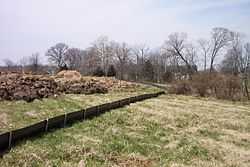Silt fence

A silt fence, sometimes (misleadingly) called a "filter fence," is a temporary sediment control device used on construction sites to protect water quality in nearby streams, rivers, lakes and seas from sediment (loose soil) in stormwater runoff. Silt fences are widely used on construction sites in North America and elsewhere, due to their low cost and simple design,[2] although their effectiveness in controlling sediment is often rather limited, due to problems with design, installation and/or maintenance.[3]
Design and installation
Silt fences are perimeter controls, typically used in combination with sediment basins and sediment traps, as well as erosion controls, which are designed to retain sediment in place where soil is being disturbed by construction processes (i.e., land grading and other earthworks).[4]

A typical fence consists of a piece of synthetic filter fabric (also called a geotextile) stretched between a series of wooden or metal fence stakes along a horizontal contour level. The stakes are installed on the downhill side of the fence, and the bottom edge of the fabric is trenched into the soil and backfilled on the uphill side. The stormwater slowly passes through the fence while depositing its sediments on the uphill side of the fence. The fence is not designed to concentrate or channel stormwater. The fence is installed on a site before soil disturbance begins, and is placed down-slope from the disturbance area.[5][6]
Sediment is captured by silt fences primarily through ponding of water and settling, rather than filtration by the fabric. Sand and silt tends to clog the fabric, and then the sediments settle in the temporary pond.[7]:p.6-9 [8]:p.7-46
Super silt fence
Some government jurisdictions in the United States recommend or require the use of a reinforced fence, sometimes called a "super" silt fence or an enhanced silt fence, on some construction sites. This design uses filter fabric reinforced by a wire mesh or chain link fence. The metal backing gives the fence increased strength to resist the weight of soil and water which may be trapped by the fence in a large drainage area, and discourages construction site operators from driving vehicles over the fence.[9] However, an improper installation of a super silt fence can create an inadvertent sediment basin if the filter fabric becomes clogged. This typically causes flooding, failure of the fence, and increased downstream pollution.
Effectiveness

Silt fence fabrics (geotextiles) tested in laboratory settings have shown to be effective at trapping sediment particles.[10]:45-47 Although there have been few field tests of silt fences installed at construction sites, these tests have shown generally poor results.[10]:27-31, 53-55 (Effectiveness testing involved measurements for both total suspended solids and turbidity.) Other studies and articles about silt fence usage and practice document problems with installation and maintenance, implying poor performance.[11]
Silt fences may perform poorly for a variety of reasons, including improper location (e.g. placing fence in an area with concentrated stormwater flows), improper installation (e.g. failure to adequately embed and backfill the lower edge of fabric in the soil) and lack of maintenance.[7]:p.6-10 The fabric may become damaged with holes and tears if construction materials are stored next to or on top of the fence. During various phases of construction at a site, a silt fence may be removed relocated and reinstalled multiple times.[10]:30-31 It may be difficult to maintain effectiveness of a silt fence under such operating conditions. Location of fences in areas with high flows may lead to fence failures.[8]:p.7-46
Static slicing installation
Some state agencies recommend an installation technique called "static slicing" as an improved method for ensuring effectiveness and longevity of a silt fence system on a construction site. The technique involves inserting a narrow blade into the soil and simultaneously inserting the silt fence fabric while the blade is moving. This step is followed by mechanical soil compaction, setting of fence posts, and attaching the fabric.[12]
See also
- Geosynthetics
- Geotechnical engineering
- Nonpoint source pollution
- Stormwater
References
- ↑ EPA (2007). “Developing Your Stormwater Pollution Prevention Plan: A Guide for Construction Sites.” Document No. EPA-833-R-060-04.
- ↑ Sprague, C.J. (1999). "Assuring the Effectiveness of Silt Fences and Other Sediment Barriers." Proceedings of Conference 30, International Erosion Control Association, Nashville, TN. pp. 133-154.
- ↑ Brzozowski, Carol (Nov–Dec 2006). "Silt Fence Installation". Erosion Control (Forester Media) 13 (7).
- ↑ Commonwealth of Virginia. Department of Conservation and Recreation (VA DCR). Richmond, VA. “Virginia Erosion and Sediment Control Handbook: Principles, Practices and Costs.” Chapter 2. 1992.
- ↑ VA DCR. “Virginia Erosion and Sediment Control Handbook: Silt Fence.” Chapter 3 - Standard and Specification No. 3.05. 1992.
- ↑ U.S. Environmental Protection Agency (EPA), Washington, DC (2012). "Silt Fences." Stormwater Best Management Practice. Document no. EPA 833-F-11-008.
- ↑ 7.0 7.1 Fifield, Jerald S. (2004). Designing for Effective Sediment and Erosion Control for Construction Sites. Santa Barbara, CA: Forester Press. ISBN 978-0-9707687-3-5.
- ↑ 8.0 8.1 EPA (2009). "Development Document for Final Effluent Guidelines and Standards for the Construction and Development Category" (Report). http://water.epa.gov/scitech/wastetech/guide/construction/upload/2009_12_8_guide_construction_files_chapters.pdf. Document No. EPA-821-R-09-010.
- ↑ Maryland Department of the Environment. Baltimore, MD. "1994 Maryland Specifications for Soil Erosion and Sediment Control." Section H - 26.0: Super Silt Fences. 1994.
- ↑ 10.0 10.1 10.2 "An Evaluation of the Use and Effectiveness of Temporary Sediment Controls" (Report). University of Texas at Austin, Center for Transportation Research. March 1996. ftp://ftp.odot.state.or.us/techserv/Geo-Environmental/Environmental/Regulatory%20Documentation%20Forms%20and%20Examples/Water%20Quality/Research%20Technical%20Documents/Barrett%20et%20al%201996.pdf. Research Report 1943-2.
- ↑ EPA (2004). "Filter Fence Design Aid for Sediment Control at Construction Sites." Document No. EPA/600/R-04/185. p.22
- ↑ Carpenter, Thomas; Sprague, Joel (Jul–Aug 2002). "Silt Fence Installation Efficacy". Grading and Excavation Contractor (Forester Media) 4 (5).
Further reading
- Smith, DeWitt (Nov–Dec 2007). "Two Ways to Install Silt Fence". Erosion Control (Forester Media) 14 (7).
- Brzozowski, Carol (Sept–Oct 2004). "Research and Testing of ESC Products and Methods". Erosion Control (Forester Media) 11 (6).
External links
- International Erosion Control Association - Professional Association, Publications, Training
- WatchYourDirt.com - An Erosion and Sediment Control Video Education Resource